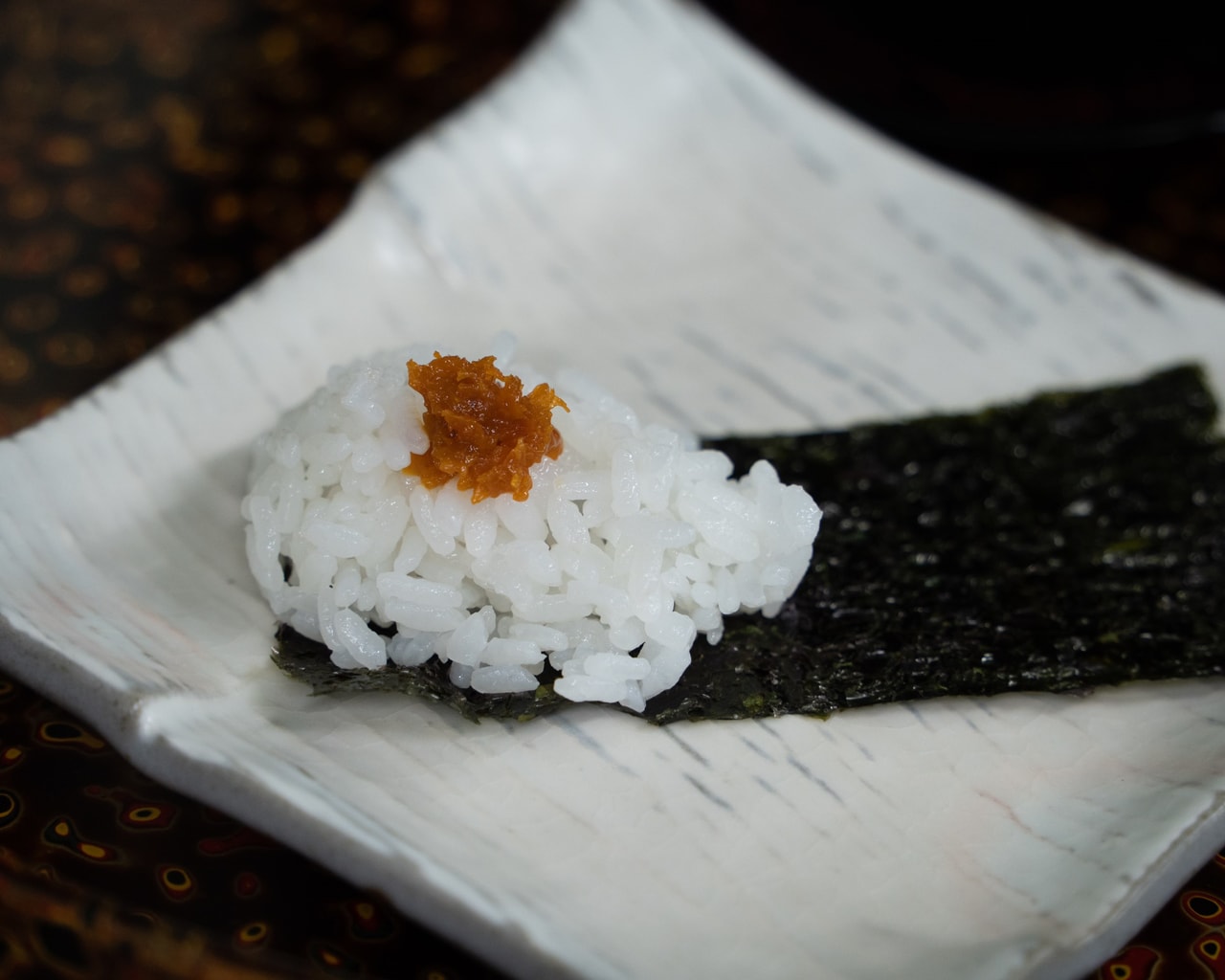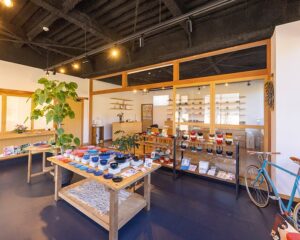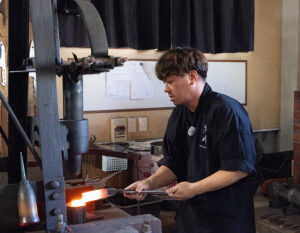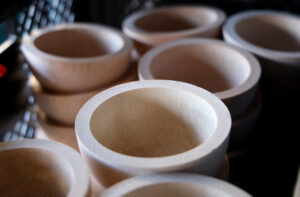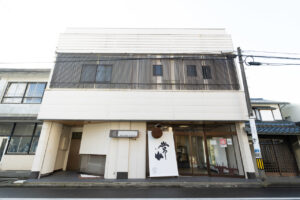Amanatsu is a long-established restaurant that offers a lineup of products made from high-quality seafood, including “Echizen Tailored Shio Uni” (sea urchin).
Shio Uni,” with its rich flavor and concentrated aroma of the sea, has a reputation for being the best tasting sea urchin
.
You can enjoy the taste created by the commitment to the region of origin, careful handiwork that has remained unchanged for over 200 years,
and an inquisitive mind for flavor.
Amanatatsu, located in Fukui City in northern Fukui Prefecture, is said to be one of Japan’s top three sea urchin delicacies, along with karasumi (dried mullet roe) and konawata (sea urchin roe). Junichi Amano, the 11th generation owner of Amanotatsu, who has inherited the 200-year history of Amanotatsu, is striving to preserve the traditional taste while looking ahead to the next 200 years and conveying the charm of “Shio-Uni” to the next generation.
Deep Relationship with the Echizen Fukui Clan
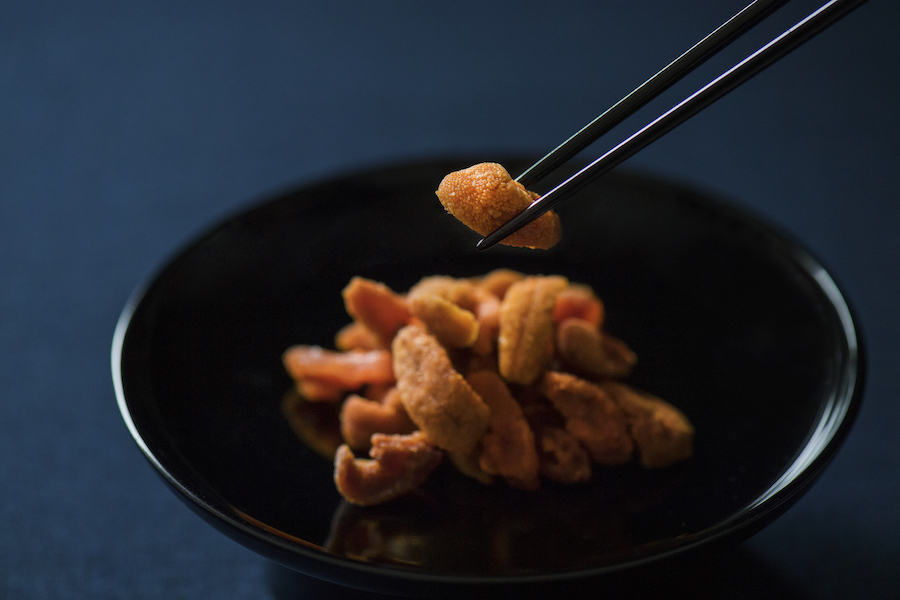
The main store of Tentatsu is located in Katamachi, a busy shopping district in the center of Fukui City. The area is dotted with historical relics , including the ruins of Fukui Castle, Yohko-kan Garden, a villa of the Echizen Fukui feudal lord, and the ruins of Kitanosho Castle, the former residence of Katsuie Shibata.
Tentatsu” was founded in 1804 as a purveyor to the Fukui Domain, and the third generation of the family, Gohee Tennouya, created salted sea urchin (product name: “Shio-Uni”). It is said that this was inspired by an order from the feudal lord of the Echizen Fukui domain to develop a food that could be stored for a long time in case of an attack on the sea.
The third generation, under orders from the feudal lord, apparently spent many days walking along the coast from Mikuni Port to Tsuruga Port in the northwestern part of Fukui Prefecture, searching for ingredients and came upon sea urchin, which had been caught in abundance since that time. He then invented the “salting method,” which is the production method for “shio uni” (sea urchin). It is said that he taught this method to fishermen and divers along the Echizen coast, who collected the sea urchin and presented it to the clan as a tribute. Because it was made on the Echizen coast, Shio-uni was also called Echizen-undan (sea urchin),” says Amano.
As time passed, the seventh generation Tenno-ya Tatsukichi was called “Tentatsu,” an abbreviation of the name of the feudal lord Matsudaira Harutake, who was considered one of the Four Wise Generals at the end of the Edo period. Because of this close relationship with the Matsudaira family, the wrapping paper for “Shio Uni” uses a map of the ruins of Fukui Castle from the Edo period as a motif.
Prepared entirely by hand
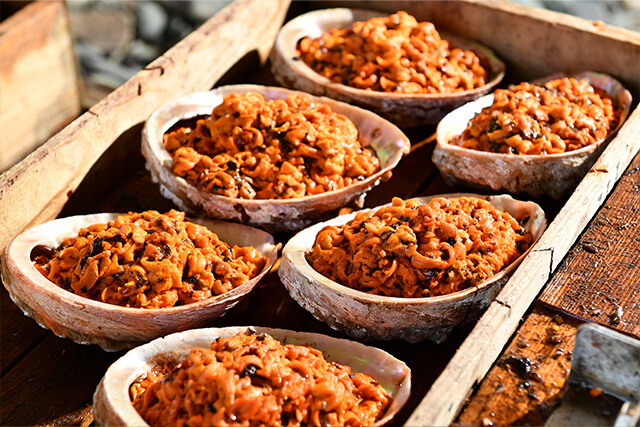
Shio Uni” is made by sprinkling salt on the ovaries of Buffoon sea urchins, draining their water, and then letting them mature to a mild flavor. Early in the morning, the divers catch the sea urchins, crack open the 2-3 cm shells, and take out the sea urchins so as not to damage their contents. The shells are then placed in the abalone shells and carefully rinsed in salt water.
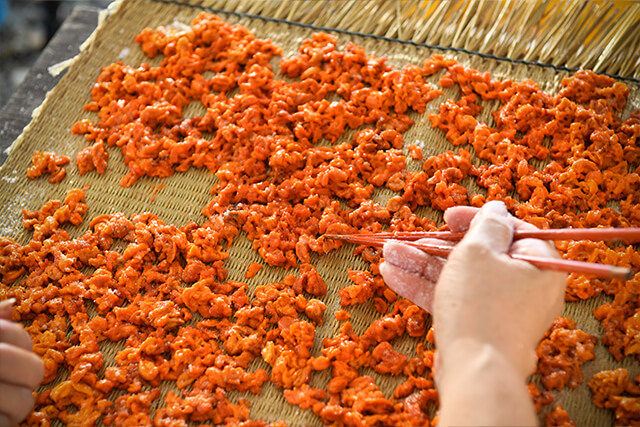
The sea urchins are then drained and placed on a coarse-mesh mat. The sea urchins are then covered with salt, turning them one by one with chopsticks to get the right “saltiness”. The sea urchin is then placed on a coarse sesame mat, and each sea urchin is turned over one by one with chopsticks and sprinkled with salt to the right “saltiness”.
The careful preparation of the sea urchin by hand and the scarcity of more than 100 pieces of sea urchin required to make 100 grams of “Shio Un i “ are the reasons why it is called the highest quality sea urchin.
A special gift in a paulownia wood box
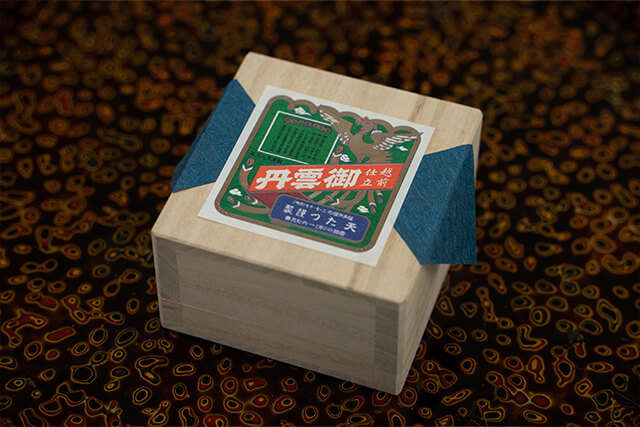
It is said that “Shio-uni” was invented as a preservative food for the “ikusa” (a kind of warship). It is said that “even though it was a preserved food, since it was to be presented to the lord, he must have sought novelty and deliciousness. I think the fruit of these efforts was ‘shio uni’ (sea urchin),” Amano surmises. As the peace of Edo continued, “shio uni” became not only a preserved food but also a delicacy representative of the Fukui clan. Because it lasted for a long time, it was also valued as a gift, and the feudal lord allowed it to be placed in a paulownia box.
The tradition of packing in paulownia boxes, which enhanced the value of the product as a gift in the Edo period, has been handed down to the present day. Along with plastic containers with high preservation qualities, and pottery and lacquered containers, “Shio-Uni” in a paulownia box still retains its special value as a gift for a loved one.
Looking ahead to the next 200 years
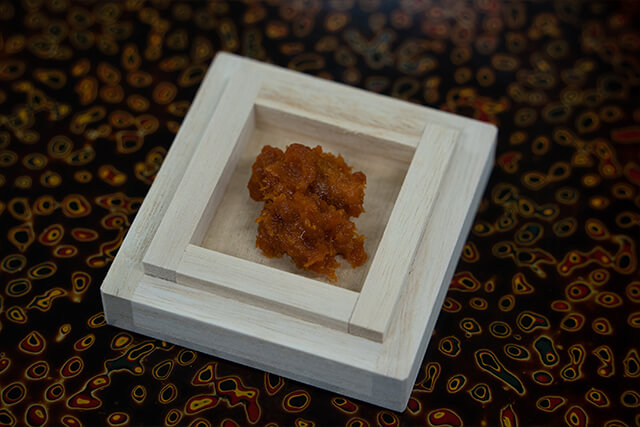
The “history” that has continued since the Edo period has enhanced the value of the “Shio Uni” brand. As the heir to this history, the current owner, Mr. Amano, has a growing sense of urgency. The reason is that the catch of the raw material, the Buffoon sea urchin, has been decreasing nationwide. The catch from Fukui Prefecture has dropped to one-tenth of its peak.
In recent years, “Tentatsu” has been visiting all over Japan to cultivate production areas other than its home prefecture of Fukui, such as Tottori and Nagasaki. The company also purchases “shio uni” produced not only in Japan but also in overseas regions. All of them are made from buffoon sea urchins.
Amano says, “We want to continue to use the small, rich-tasting buff sea urchin from the Echizen coast for our ‘Shio Uni,’ which is made from the same sea urchin. The “sweetness” unique to buff sea urchin is the reason why he insists on using buff sea urchin. I have also tried purple sea urchin and red sea urchin. In my opinion, the purple sea urchin is not as sweet as the red sea urchin. The soft sweetness of the Buffoon sea urchin fills the mouth. He also thinks that the diversity of the sea urchin’s region of origin is an attractive feature of the product. Red sea urchins come from a limited number of regions. Buffoon sea urchins come from a wide variety of regions, so you can enjoy different flavors in each region.
The reason why Amano makes his “Shio-Uni” in the places where they are caught, and why Amano buys it from them, is because he wants to respect the food culture unique to the region.
In order to protect the marine resource of the buffoon sea urchin, Mr. Amano is participating in an effort to fully cultivate the buffoon sea urchin with the Fukui Prefectural Fisheries Experiment Station, university professors researching sea urchin cultivation, and fishermen.
Blending sea urchins to determine their maturity
The sea urchins collected at Tentatsu are left to mature at low temperatures for one, two, and three years. The staff, who are called “blenders” at Tentatsu, blend the sea urchin to the optimum blend after determining the state of maturity of each sea urchin. Shio uni (sea urchin) from Hokkaido, Tottori, and Nagasaki is used. The blended sea urchin becomes Ten-Tatsu’s signature product , Echizen-Shite Shio Uni. This aging and blending technique is the source of the delicious taste.
Mr. Amano is confident in saying that this is the best time to taste it.
A research conducted jointly by the Fukui Prefectural Food Processing Research Institute and Tentatsu revealed that the bitterness component of Shio Uni is reduced by aging, and the umami and sweetness of the sea urchin are relatively enhanced. What we had known from experience was now scientifically proven.
Conveying Flavor by Production Area
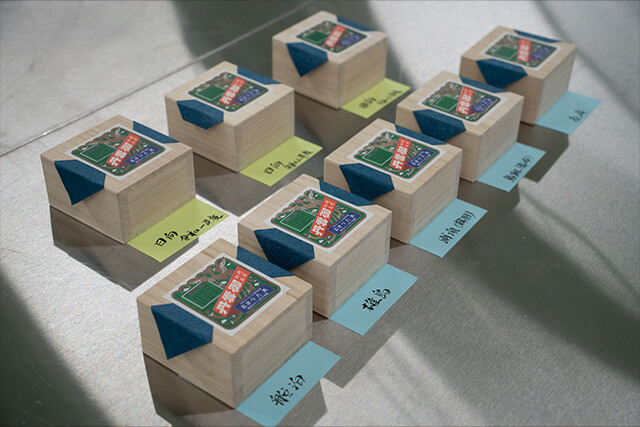
In October 2022, the company began selling “Shio Uni” according to region of production as a new trial. Only at the main Amanatatsu store, customers can purchase shio uni from Oshima Beach in Fukui, Pohang in Korea, and Funadomari in Hokkaido. Because of the limited number of sea urchins available, they are not sold at branches or via the Internet.
This is an attempt to convey the fact that sea urchins are omnivorous and their taste varies depending on the sea in which they are grown. For example, sea urchins from Fukui are characterized by their rich flavor and sweetness, with a moderate saltiness in the aftertaste. The Korean product has a mellow taste with an aroma of the seashore. Hokkaido produce has a moderately bitter and salty taste.
In 2011, the company revived “dried sea urchin,” which once ceased to exist in the early Showa period. Unlike “Shio-Uni,” which is made by pickling sea urchin in salt water, “Dried Sea Urchin” is made by heating sea urchin in salt water and then drying it. The company has also expanded product variations based on “Shio-Uni. Powdered Sea Urchin” is a luxurious sprinkling of “Echizen Tailored Shio Uni” that has been dried and powdered. Undan Awase” combines the sauce made from “Shio Uni” with natural abalone, snow crab, sweet shrimp, and other ingredients.
Fusion of tradition and modernity
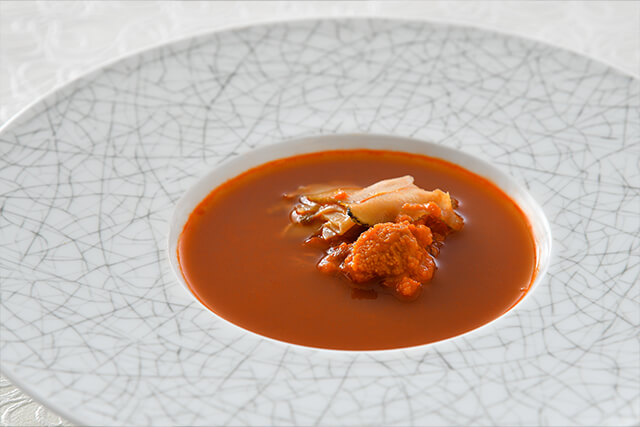
The company is also beginning to fuse the traditional Japanese ingredient “shio uni” with Western cuisine. They have developed Western-style products such as “Sea Urchin Bisque,” which uses sea urchin in bisque, a French soup, and “Sea Urchin Gratin. Recently, they have added a new product, “Unotan Ahijo,” in which sea urchin is simmered in olive oil and garlic.

Shio Uni has long been loved as a snack with sake, but it is also excellent on rice. We would like to propose ways to eat it and offer variations in cooking so that people, especially the younger generation, who are unfamiliar with shio uni will discover its deliciousness,” says Amano.
We have also asked chefs from Michelin-starred restaurants to help us explore the possibilities of Shio Uni as an ingredient. At a collaboration dinner between famous chefs from Tokyo and Fukui, a specialty dish was served with caviar and “Shio Uni”.
Amano continues to update its products to pass on its ancient traditions to the future, and in the fall of 2022, a new factory with thorough temperature control and hygiene management will be opened. At the new factory, Mr. Amano talks about his dream. I want to continue the 200-year history of Amanatatsu for the next 200 years. I want to continue the 200-year history of Amano’s sea urchins and deliver to the world the joy that can only be experienced at Shio Uni.
In the eyes of the 11th generation owner, I see a future in which the Fukui-born food culture, which has been passed down through a series of new changes, will attract the attention of the world.
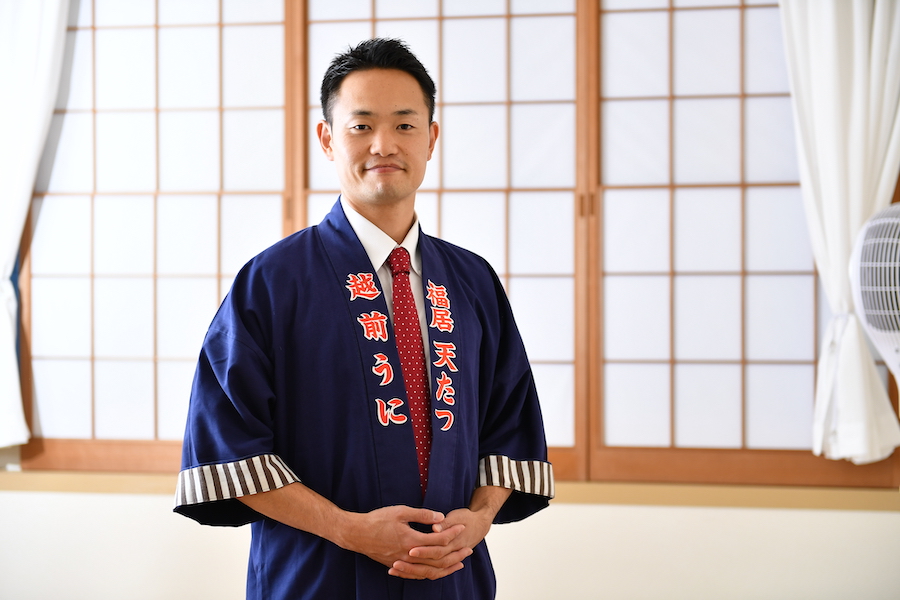
People’s tastes and preferences change with the times, and although Shio Uni has been around for more than 200 years, Amano aims to create the most delicious taste of each era. We want our customers to simply enjoy our delicious sea urchins. Our spirit will never change, and we will continue to pursue the taste of our local delicacy in gratitude to our hometown, Fukui.



